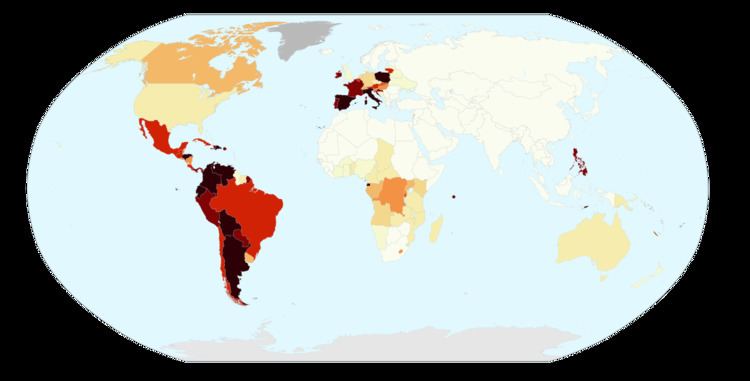 | ||
The Catholic Church in Mongolia is part of the worldwide Catholic Church, under the spiritual leadership of the Pope in Rome. There are around 1,000 Catholics in the country who are served by three churches in the capital Ulaanbaatar, plus churches in Darkhan, Arvaikheer, Erdenet and mission stations that may grow into churches.
Contents
Roman Catholicism was first introduced in the 13th century during Mongol empire, but died out with the demise of the Yuan Dynasty in 1368. New missionary activity only set in after the Second Opium War in the mid-19th century. A mission was founded for Outer Mongolia, giving Mongolia its first Roman Catholic jurisdiction, but all work ceased within a year when a communist regime came to power.
With the introduction of democracy in 1991, Roman Catholic missionaries returned and rebuilt the church from scratch. As of 2016, there is an Apostolic Prefecture, a bishop, six churches, and diplomatic relations between the Holy See and Mongolia since 4 April 1992.
History
The Roman Catholic Church in Mongolia has ancient roots. Nestorian Christianity had been practiced since the 7th century, and in the 13th century, Western missionaries such as William Rubruck and Giovanni da Pian del Carpine and Armenian King Hethum I came to the region. Armenian King Hethum I, Giovanni da Pian del Carpine and William Rubruck visited Mongolia. The leaders of the Mongol Empire were traditionally tolerant of many religions, through Christianity was a key religious influence, primarily through the wives of the Mongolian khans, women from the Church of the East Keraites. John of Montecorvino was a key missionary to Mongol-controlled China during the Yuan Dynasty, translating the New Testament and the Psalms into the Mongol tongue, founding the first Roman Catholic mission in Beijing and becoming its first bishop.
Technically Mongolia had been covered by the diocese of Peking, and it was not until 1840, when a Vicariate Apostolic was divided from Beijing that Mongolia had its own Catholic jurisdiction. In 1883, a vicariate for Inner Mongolia was created, and then a mission was created for Outer Mongolia in 1922. Freedom of thought and religion were not permitted under communist rule.
Mission sui iuris (1991–2003)
The new Mongolian Constitution of 1992 guaranteed religious liberty, and missionaries were sent to reconstitute the church. Missionhurst (the Congregation of the Immaculate Heart of Mary) sent priests Fathers Wenceslao Padilla, Gilbert Sales and Robert Goessens to accomplish this mission once the Vatican had established diplomatic relations with Mongolia. Previous to their arrival, expatriates had been attending Protestant services. Initially, none of the missionaries knew Mongolian, none of the native peoples knew English, and there were no Catholic liturgical texts printed in Mongolian. The first masses were held in rented apartments and consisted of foreigners working for embassies and foreign aid organizations.
By 1996, Father Wince Padilla and 150 parishioners were on hand at the dedication of the first Catholic Church in Mongolian history. In 1997 the first papal nuncio to Mongolia from the Holy See was named. The new Cathedral of Saints Peter and Paul in Ulaanbaatar is shaped like a traditional ger, with its circular tent shape and walls of thick felt.
Prefecture Apostolic (2003–present)
On August 23, 2003, Cardinal Crescenzio Sepe (head of the Vatican Congregation for the Evangelization of Peoples) arrived and consecrated Father Padilla as the first bishop of Mongolia, although the country is not yet a diocese. Pope John Paul II apologized for being unable to attend the opening himself, as he had been planning to visit Mongolia, a first for a pope. He had originally been invited by the President of Mongolia during his visit to the Vatican in 2000. There are now 54 missionaries from various countries helping to build up the church, and 3 functioning parishes. The flocking of Christian missionaries has been notable since the fall of communism, and Catholicism grew from no adherents in 1991 to over 600 in 2006, including about 350 native Mongolians.
A Mongolian version of the Catholic catechism was printed mid-2004; it is done in traditional Mongolian writing style and includes common Catholic prayers. The mission runs a kindergarten, English classes, a technical school, soup kitchens, two farms, and a care center for 120 disabled children. Another course offered is how to deal with anger management, in order to help uproot domestic violence. The Verbist Center has also taken in 120 street children who had previously been living in Ulaanbaatar's sewer system. Christmas is not a national holiday in Mongolia, as the proportion of the population that is Christian is very low. A fourth parish was founded in 2007 in Darkhan, Mongolia's second-largest city. In 2008, Joseph Enkh Baatar became the first Mongolian Catholic to join a seminary to become a priest. He was later ordained as the first Mongolian deacon in December 2014. On August 27, 2016 Joseph Enkh Baatar was the first native Mongolian to be ordained as a priest. More than 1,500 people attended the ordination Mass, including nearly 100 priests from South Korea, dignitaries of foreign embassies, local Orthodox churches, and Buddhist monks. As of 2016 there were three seminarians for Mongolia studying in Daejeong, South Korea. The Mongolian Catholics also dedicated its first Catholic grotto in 2008.
Legal restrictions
People under the age of 16 can only receive catechesis with written parental consent and professions of faith are only allowed in church buildings. Priests may not dress in clerical clothing in public.
